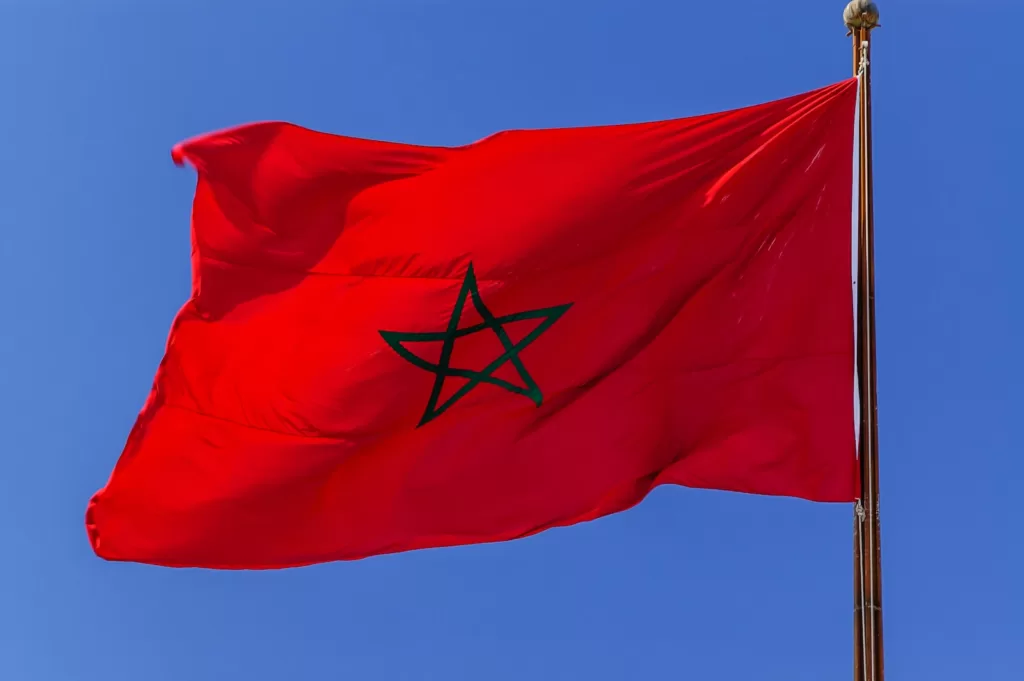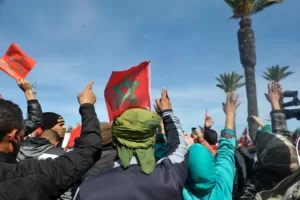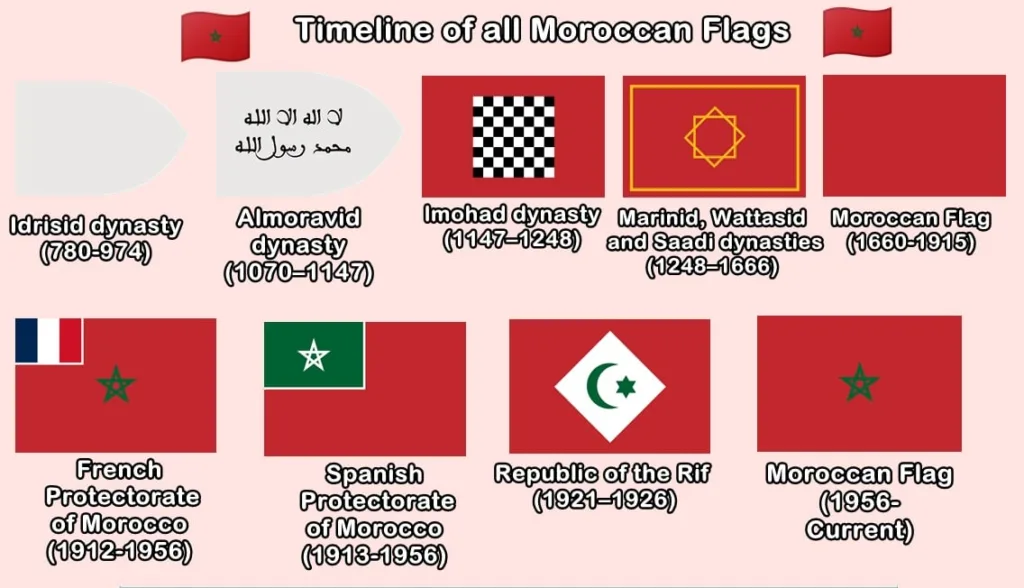The flag of Morocco, also known as the Moroccan flag, is the national flag of the Kingdom of Morocco. It holds deep historical and cultural significance for the Moroccan people. Let’s explore the colors, symbolism, and captivating history behind this iconic flag.

Key Takeaways:
- The Morocco flag is the national flag of the Kingdom of Morocco.
- It has a red field with a green pentagram in the center.
- The red color represents power, courage, bravery, and unity.
- The green color symbolizes hope, wisdom, joy, peace, and love.
- The pentagram represents the five pillars of Islam.
- The flag’s design has remained unchanged since its adoption in 1915.
History of the Flag of Morocco
The history of the Moroccan flag dates back centuries, with the Idrisid dynasty being the first to hoist a flag in 788. Over the years, different dynasties introduced variations of the flag with various symbols and colors.
In 1915, the current design with a red field and green pentagram was officially adopted. The red color represents power, courage, bravery, and unity, while the green color symbolizes hope, wisdom, joy, peace, and love. The pentagram, with its religious significance, represents the five pillars of Islam.
During the period when Morocco was under French and Spanish control, the use of the flag was restricted. However, after gaining independence in 1956, the flag returned to being the national symbol of Morocco, representing the pride, history, and identity of the Moroccan people.
Throughout its history, the flag of Morocco has evolved and adapted to reflect the country’s changing circumstances. It has become a powerful symbol of Moroccan nationalism and resilience.
The Moroccan flag serves as a reminder of the struggles and triumphs of the Moroccan people throughout history, including periods of colonization and occupation.
Today, the flag stands tall, representing the unity, strength, and vibrant culture of Morocco.
Meaning behind the Colors of the Flag of Morocco
The colors of the Moroccan flag hold significant meaning. The red color represents power, courage, bravery, and unity. It symbolizes the connection between God and the nation, as well as the blood of the ancestors. The green color symbolizes hope, wisdom, joy, peace, and love. It is also associated with Islam and paradise. Together, the colors represent the rich heritage, faith, and spirit of the Moroccan people.

To truly understand the symbolism of the Moroccan flag colors, it is essential to delve into their historical and cultural significance. The combination of red and green reflects the values and aspirations of the Moroccan people.
“The red color in the Moroccan flag represents power, courage, bravery, and unity.”
“The green color symbolizes hope, wisdom, joy, peace, and love.”
The red color signifies strength, resilience, and the determination of the Moroccan people to protect their nation’s sovereignty. It represents the powerful connection between God, the country, and its people. Additionally, red also symbolizes the bloodshed of the ancestors who fought for freedom and independence.
The green color, on the other hand, reflects the faith, hope, and prosperity of Morocco. It represents the nation’s commitment to peace, love, and harmony. It is deeply tied to Islam, the dominant religion in Morocco, and signifies the spiritual aspects of the country.
The red and green colors come together to embody the rich cultural heritage, national identity, and values of Morocco. They serve as a reminder of the collective history, aspirations, and unity of the Moroccan people.
Design and Symbolism of the Moroccan Flag
The design of the Moroccan flag is simple yet meaningful. It features a red field with a green pentagram at the center. The pentagram represents the five pillars of Islam – the testimony, prayer, alms-giving, fasting, and pilgrimage. It is also known as the Seal of Solomon, a symbol with historical and religious significance. The emblem on the flag represents the country’s strong connection to Islam and its commitment to upholding its principles.
The Moroccan flag design showcases a striking contrast between the vibrant red field and the bold green pentagram. The red color signifies power, courage, bravery, and unity, while the green color symbolizes hope, wisdom, joy, peace, and love. Together, these colors reflect the rich heritage and spirit of the Moroccan people.
The pentagram, with its intricate geometric shape, holds deep meaning in the Moroccan flag. It represents the five pillars of Islam, which are fundamental principles of the Islamic faith. These pillars include the testimony of faith, prayers, giving to the needy, fasting during Ramadan, and the pilgrimage to Mecca. The pentagram is a potent symbol that highlights the country’s strong Islamic identity and its adherence to these core principles.
The emblem on the Moroccan flag is a powerful representation of the country’s connection to Islam. It serves as a constant reminder of Morocco’s commitment to upholding the values and teachings of Islam. The emblem’s prominent position at the center of the flag further emphasizes its significance and importance.
“The Moroccan flag’s design and symbolism capture the essence of the country’s heritage and religious faith. It is a visual representation of Morocco’s identity and values.”
Historical Flags of Morocco
| Period | Significance | |
|---|---|---|
| Idrisid dynasty | The flag of the Idrisid dynasty was one of the earliest flags associated with Morocco. It featured a green field with a golden crown. | |
| Alawid dynasty | The Alawid dynasty adopted a red flag with a white inscription representing Islam in the 17th century. This flag is still used as the royal flag of Morocco today. | |
| Republic of the Rif | The Republic of the Rif, a short-lived political entity in the early 20th century, had its own flag. It featured horizontal stripes of red, green, and white representing the Berber, Arab, and European influences in the region. | |
| French and Spanish protectorate | During the period of French and Spanish control, Morocco had separate flags for each protectorate. The French flag had a tricolor design of blue, white, and red, while the Spanish flag featured horizontal stripes of yellow and red. | |
| Almohad Caliphate | The Almohad Caliphate, an influential Berber-Muslim empire in the 12th and 13th centuries, had a red flag with a centered green palm tree. |

The historical flags of Morocco represent different periods and aspects of the country’s rich history and sovereignty. From the early flags of the Idrisid and Almohad dynasties to the distinct flags of the French and Spanish protectorates, each flag tells a story of Morocco’s past. The flag of the Alawid dynasty is particularly significant, as it is still used as the royal flag today. The Republic of the Rif flag reflects a unique moment in Moroccan history when the region declared its independence. These flags are a testament to the enduring legacy and pride of the Moroccan people.
Other National Flags and Emblems in Morocco
In addition to the national flag, Morocco has several official flags and emblems that hold significant meaning and represent various aspects of the country’s identity and heritage.
Morocco Civil Ensign
The Morocco Civil Ensign is an important flag used in civilian maritime activities. It features a design similar to the national flag, with a red field and a green pentagram in the center. However, the Civil Ensign includes additional embellishments, such as a crown, to differentiate it from the national flag.
Morocco Naval Ensign and Naval Jack
The Morocco Naval Ensign and Naval Jack are flags specifically designed for maritime use by the Moroccan Navy. Both flags incorporate the same design elements as the national flag, with a red field and a green pentagram. The Naval Ensign is used as a naval ensign on Moroccan naval vessels, while the Naval Jack is flown on the bow (front) of the ship as a symbol of the ship’s nationality.
Morocco Royal Flag
The Morocco Royal Flag is a unique flag that symbolizes the monarchy and the reigning royal family. It features the green pentagram, bordered with a golden fimbriation, on a red field. The Royal Flag distinguishes itself from the national flag and other official flags, representing the royal authority and the country’s deep connection to its rich history and traditions.
These flags and emblems play an important role in representing different facets of Moroccan society and culture. Whether it’s the Civil Ensign representing civilian maritime activities, the Naval Ensign and Jack representing the Moroccan Navy, or the Royal Flag symbolizing the monarchy, each flag carries its own significance and contributes to the overall patriotic spirit of the Moroccan people.
| Flag | Description |
|---|---|
| Morocco Civil Ensign | Similar to the national flag with additional embellishments |
| Morocco Naval Ensign | Used on naval vessels to represent Moroccan Navy |
| Morocco Naval Jack | Flown on the bow of Moroccan naval ships |
| Morocco Royal Flag | Represents the monarchy and the royal family |
Flag Etiquette and Importance in Morocco
In Morocco, the national flag holds significant importance and is treated with the utmost respect. Flag etiquette is strictly followed, and there are rules and regulations governing its display and use. Understanding and adhering to these guidelines is essential to honor the flag and reflect the values of the nation.
The Moroccan flag represents the country’s rich history, vibrant identity, and cherished values. It is a source of pride and unity for the Moroccan people, and it is celebrated during national holidays and important events.
When the Moroccan flag becomes worn, faded, or tattered, it should be retired in a dignified manner. According to flag etiquette, the proper disposal method is to burn the flag privately, with respect and reverence. This ensures that the flag is accorded the honor it deserves.
It is important to note that flag burning in Morocco holds a different meaning than in some other countries. In Morocco, flag burning is seen as a dignified act and a way to show respect to the nation’s flag. It is not considered a form of protest or disrespect but rather a way to retire an old or damaged flag. This unique cultural practice highlights the deep reverence Moroccans have for their national flag.
The Importance of Flag Etiquette in Morocco
Flag etiquette in Morocco emphasizes the proper use, display, and care of the flag. It reflects the country’s commitment to upholding values of unity, respect, and equality among nations. Some key aspects of flag etiquette in Morocco include:
- Never fly the Moroccan flag higher or lower than other nations’ flags, as this symbolizes equality among nations.
- Respecting the flag’s design and symbolism by ensuring it is not defaced or altered in any way.
- Displaying the flag with pride and care, using appropriate flagpoles or stands.
- Keeping the flag clean and in good condition, replacing it when it becomes worn or damaged.
By following these guidelines, Moroccans demonstrate their deep respect for the national flag and the values it represents. The flag serves as a powerful symbol of unity, heritage, and faith, and upholding flag etiquette is a way to honor and preserve these important aspects of Moroccan culture.
Interesting Facts about the Flag of Morocco
While the flag of Morocco is well-known for its vibrant red and green colors, there are some lesser-known and fascinating facts associated with this national symbol. Let’s explore some intriguing details:
The Largest Morocco Flag
Did you know that Morocco holds the record for having the largest flag ever draped? Certified by the Guinness Book of Records, the colossal flag measures an impressive size and serves as a testament to the country’s pride and patriotism. It stands as a striking visual representation of Morocco’s rich heritage and national identity.
The Morocco Flag in American History
While the Moroccan flag is a powerful symbol within its own country, it has also played a significant role in American history. The flag’s design and symbolism resonate with the principles of freedom and resistance, making it a powerful emblem for those fighting for independence and equality. Throughout American history, the Moroccan flag has been proudly displayed as a symbol of strength, resilience, and solidarity.
The Design and Symbolism
Representing the deep cultural and religious roots of Morocco, the flag’s design and symbolism hold profound significance. The vibrant red field embodies power, courage, bravery, and unity, while the lush green pentagram signifies hope, wisdom, joy, peace, and love. Together, these elements convey the enduring spirit and values of the Moroccan people.
An Insightful Comparison
| Fact | Flag of Morocco | Flag of the United States |
|---|---|---|
| Colors | Red and Green | Red, White, and Blue |
| Design | Red field with a green pentagram | 13 alternating red and white stripes with a blue canton featuring 50 white stars |
| Symbolism | Power, courage, unity, hope, wisdom, joy, peace, and love | Freedom, loyalty, justice, and perseverance |
Conclusion
The flag of Morocco holds deep significance as a representation of the country’s history, heritage, and identity. Its vibrant red and green colors embody the values of power, courage, unity, hope, wisdom, joy, peace, and love. The green pentagram, symbolizing the five pillars of Islam, serves as a powerful connection between God and the Moroccan nation.
For over a century, the design and symbolism of the Moroccan flag have remained constant, reflecting the unwavering pride and faith of the Moroccan people. The flag stands as a beacon, proudly displayed to commemorate the rich history and cultural diversity of Morocco.
When Moroccans fly their flag, it is a testament to their deep-rooted admiration for their nation and its enduring values. It is a visible celebration of Morocco’s vibrant past and the strength of its collective spirit. The flag not only symbolizes the country’s journey but also embodies the hopes, dreams, and aspirations of its people.
Whether it’s waving proudly during national holidays or adorning government buildings, the flag of Morocco serves as a unifying force that brings together the hearts and minds of Moroccans across the globe. It is a reminder of the country’s rich heritage and a symbol of the shared values that bind its citizens together.
FAQ
What is the history of the Moroccan flag?
The history of the Moroccan flag dates back centuries, with the Idrisid dynasty being the first to hoist a flag in 788. Over the years, different dynasties introduced variations of the flag with various symbols and colors. In 1915, the current design with a red field and green pentagram was officially adopted. During the period when Morocco was under French and Spanish control, the use of the flag was restricted. However, after gaining independence in 1956, the flag returned to being the national symbol of Morocco.
What do the colors of the Moroccan flag represent?
The red color represents power, courage, bravery, and unity. It symbolizes the connection between God and the nation, as well as the blood of the ancestors. The green color symbolizes hope, wisdom, joy, peace, and love. It is also associated with Islam and paradise. Together, the colors represent the rich heritage, faith, and spirit of the Moroccan people.
What is the design and symbolism of the Moroccan flag?
The design of the Moroccan flag is simple yet meaningful. It features a red field with a green pentagram at the center. The pentagram represents the five pillars of Islam – the testimony, prayer, alms-giving, fasting, and pilgrimage. It is also known as the Seal of Solomon, a symbol with historical and religious significance. The emblem on the flag represents the country’s strong connection to Islam and its commitment to upholding its principles.
What are some historical flags of Morocco?
Throughout history, Morocco has had several variations of flags under different dynasties and periods of foreign control. These include the flags of the Idrisid dynasty, the Almohad Caliphate, the Marinid dynasty, the Alawite dynasty, the French and Spanish protectorate flags, and the flag of the Republic of the Rif. Each of these flags represented different periods and aspects of Morocco’s history and sovereignty.
What are the other national flags and emblems in Morocco?
In addition to the national flag, Morocco has other official flags and emblems. These include the civil ensign, naval ensign, naval jack, and royal flag. The civil ensign is similar to the national flag but includes a crown and additional embellishments. The naval ensign and naval jack also incorporate the national flag but with specific designs for maritime use. The royal flag features the green pentagram bordered with a golden fimbriation.
What is the importance of flag etiquette in Morocco?
The Moroccan flag holds great importance and is treated with utmost respect. Flag etiquette is strictly followed, with rules and regulations governing its display and use. When the flag becomes worn or tattered, it should be burned in a private place with respect. It is forbidden to fly the flag higher or lower than other nations’ flags, as it symbolizes equality among nations. The flag represents the country’s history, identity, and values and is celebrated during national holidays and events.
What are some interesting facts about the flag of Morocco?
One notable fact is that the largest flag ever draped was in Morocco, certified by the Guinness Book of Records. The flag has also been used as a symbol of resistance in American history. Furthermore, the flag’s design and symbolism have deep roots in Moroccan culture and Islam, reflecting the country’s rich heritage and national identity.




